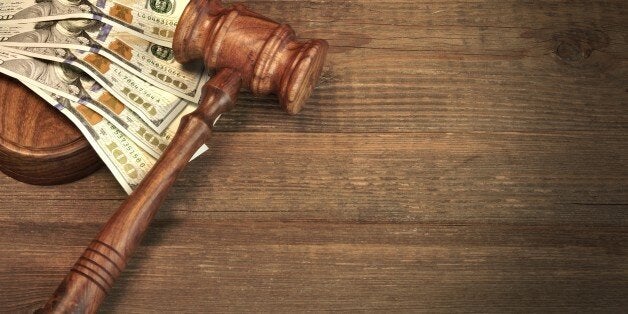
Given the stark statistics, it is not surprising that much of the discussion around fixing our criminal justice system focuses on mass incarceration. About 2.2 million Americans are now behind bars, and Federal, State, and local jurisdictions spend $80 billion a year keeping them there. At the same time, incarceration disproportionately affects the poor and communities of color: while African Americans and Latinos make up 30 percent of our population, they make up 60 percent of our inmates.
But this crucial discussion misses another aspect of our criminal justice system that disproportionately affects the least-advantaged: the growing use of monetary payments such as fines, fees, and bail. A new issue brief from the Council of Economic Advisers highlights why those interested in reforming the criminal justice system should take a hard look at the use of these payments -- which, because they do not take into account a defendant's ability to pay, punish poorer defendants more than wealthier defendants -- in addition to addressing incarceration.
The use of fines and fees has grown dramatically in the past three decades: in 1986, 12 percent of those incarcerated were also fined, but by 2004 this number had tripled. Two-thirds of all prison inmates now have criminal justice debts, and 44 States charge formerly incarcerated individuals for probation and parole supervision.
Rising budgetary pressure drives part of the rise in payments. State and local governments now spend about 1.6 times what they did in the early 1990s on criminal justice in real terms. These jurisdictions, which pay many of the operational costs of the criminal justice system, have increasingly turned to monetary sanctions like fines, fees, and bail as a source of additional revenue.
Each of these payments serves a different purpose: fines attempt to deter crime or punish offenders; fees directly support operational costs in the criminal justice system by charging offenders itemized payments; and bail is supposed to incentivize defendants released before trial to appear at court.
Despite their different goals, all three of these payments have something in common: in the United States, the amount charged to a defendant usually does not take into consideration his or her ability to pay; it is instead based solely on the offense charged. These fixed payments are what economists call regressive: they impose greater costs on poorer defendants than on wealthier ones, since the former have to pay a larger portion of their income for a given offense. This is particularly troubling because these policies can lead to incarceration for individuals unable to pay fines and fees or post bail, raising constitutional and due process concerns.
Low-income individuals with criminal justice debt struggle with difficult tradeoffs between paying these debts and other necessities like food and rent. Time spent in jail for failure to pay debts has large and lasting costs in terms of lost income and a higher likelihood that the offender could lose his or her job, in addition to the large human costs for the family. What is worse, unsustainable debt coupled with the threat of incarceration could actually encourage individuals to turn to criminal activity to pay off their debts, perversely increasing recidivism.
Fines and fees do not just impose large financial and human costs on poor offenders -- they are also inefficient ways to raise revenue. Because offenders tend to have lower levels of income, State and local governments are hard-pressed to actually collect on court debts: in recent years, for example, Florida and Maryland each collected less than 20 percent of some types of fees. In many cases, the costs of collection may actually exceed revenues because of the high costs and low success rate of collection efforts. When individuals are jailed for failure to pay, the cost of fee collection increases further; in Rhode Island in 2008, nearly 2,500 individuals were incarcerated for unpaid debts at an average cost of $505 per commitment. In 13 percent of these cases the cost of incarceration alone was more than the debt assessed.
At the same time, the use of bail bonds has increased over time, leading to more frequent pretrial detention of defendants. The number of un-convicted inmates in jails grew by nearly 60 percent between 1996 and 2014, and detaining defendants before court proceedings now costs about $9 billion a year. This is an especially high price tag given that research finds that many defendants held on bail are very low-risk; over 20 percent of felony defendants held on bail have a one percent or lower estimated probability of re-arrest.
Like the use of fines and fees, our current system of bail payments is not only regressive and inequitable, it is inefficient as well. Despite the growth in the use of bail in recent years and despite a drop in the rate of defendants failing to appear in court, pretrial re-arrest rates have actually increased slightly. In addition, many bail practices result in detaining the poorest rather than the most dangerous defendants before trial. For example, in New York City in 2010, 79 percent of arrestees failed to make bail at arraignment for bail amounts less than $500, which in part explains the growing interest from New York and other localities in reforming cash bail policies.
Crime imposes real costs on society in terms of both the harm done to victims and in resources that must be allocated to policing, prosecution and incarceration. But the growing use of fixed fines, fees, and bail payments raises concerns about the equity and efficiency of these regressive payments. The good news is that there are a number of potential policy options that could go a long way in addressing these issues: in over 25 countries in Europe and Latin America, for example, fines are assessed based on both the severity of the offense and the defendant's income level. Rather than relying on money bail, many jurisdictions in the United States are adopting data-driven risk-assessment models to help incorporate information on a defendant's risk level when determining pretrial release in order to stop the practice of detaining low-risk defendants simply because they cannot post bail.
Commonsense reforms to monetary punishments have the potential to improve efficiency and fairness in the criminal justice system without compromising public safety. As we engage in a national conversation on how to fix our criminal justice system, it is important to remember to look not just at mass incarceration, but also at other aspects of the system -- like regressive monetary punishments -- that are badly in need of reform.
